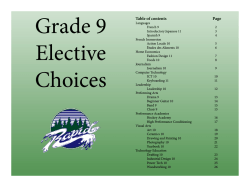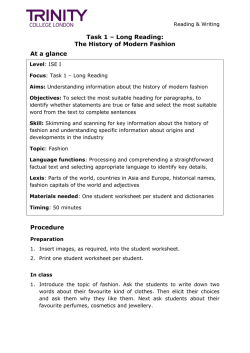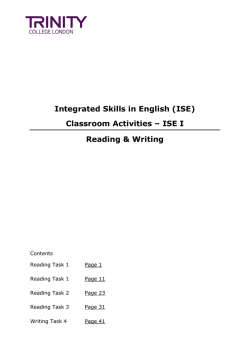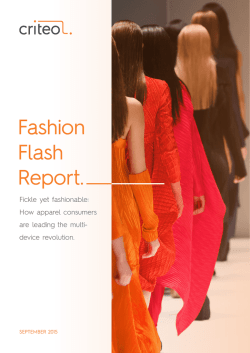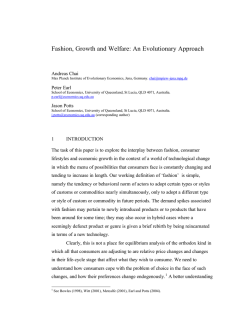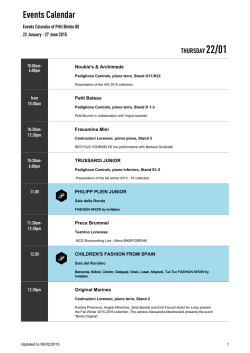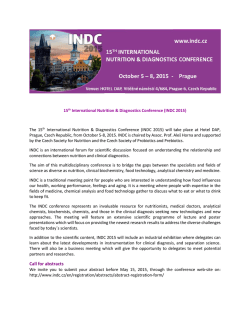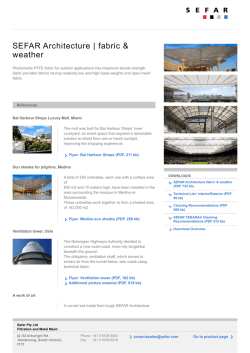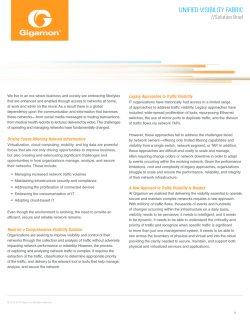
FAShION FASHION - Pacific Educational Press
P A C I F I C E D U C A T I O N A L P R E S S A nnounces e in Mad ada Can The World of Fashion Nutrition and Health NUTRITION and HEALTH the world of FAShION the NUTRITION and HEALTH world of FASHION TEACHER RESOURCE TEACHER RESOURCE PACIFIC EDUCATIONAL PRESS PACIFIC EDUCATIONAL PRESS PACIFIC EDUCATIONAL PRESS PACIFIC EDUCATIONAL PRESS Specifically developed to match the new 2013 Ontario Curriculum: Social Sciences and Humanities HNC3C—Understanding Fashion Grade 11 College Preparation HFA4C—Nutrition and Health Grade 12 College Preparation HNB4M—The World of Fashion Grade 12 University/College Preparation HFA4U—Nutrition and Health Grade 12 University Preparation w w w . pacificedpress . ca G r a d e s 1 1 – 1 2 fa m i ly s t u d i e s pacific educational press The World of Fashion addresses all CURRICULUM STRANDS: the world of FAShION curr 100% ic HNC ulum m 3C & at HNB ch 4M 201 3 Curriculum Strands The World of Fashion offers: A. Research and Inquiry Skills Multiple opportunities for students to develop and apply research and inquiry skills by: •investigating topics related to fashion •exploring real-world examples of Canadians who work in the industry •processing information (problem solving, decision making and analysis) through critical thinking articles and a cumulative research project •communicating about and reflecting upon their knowledge and understanding STUDENT RESOURCE Providing students with everything they need to explore, research, communicate about and reflect on the Canadian and global fashion industry. Comprehensive coverage of content strands through accessible and engaging topics, such as: B. HNC3C—Influences on Fashion PACIFIC EDUCATIONAL PRESS HNB4M—History and Influences The World of Fashion features articles that empower students to develop and apply critical thinking, research and inquiry skills. •textiles and the textile industry •how fashion designers create their products •factors that influence fashion trends •business aspects of the fashion industry, including the impact of marketing on consumer behaviour •the impact of globalization on the industry C. HNC3C—Marketing, Environmental Responsibility, and Consumer Behaviour HNB4M—Textile Production, Society, and the Globalized Market D. Design and Fashion Construction Skills bility t and Sustaina The Environmen A Passion for Fa shion raps? bout Fabric Sc What A Luisa Rino – Fa ric scraps you One unavoidab ards. end up with afterw earch plan. r res 3. Carry out you fabric waste y finds ways to use the scraps A garment factor ting ora orp inc as such nt, in another form, the same garme for e tur fea ign ding into another des er do to avoid sen sew e hom a but what can landfill? these scraps to the ch plan to find r, create a resear 1. With a partne are to throwing re the s tive rna out what alte into the garbage. your fabric scraps anized your e recorded and org ch. 4. After you hav analyse your resear and ess ass , information source able? (A reliable reli s rce sou r you Were the topic pected expert on is written by a res tions.) l-regarded publica and appears in wel e of bias means (Fre s? bia of Were they free ly and the information fair that they present .) ice jud pre t hou wit your class ommendations to . 5. Make two rec with fabric scraps do to at wh ut abo creative Do you know any scraps? ways to use fabric Investigating topics related to fashion r plan, identify: 2. As part of you a) your questions; ; and rces of information ec le souns sibtio Global Cob)nnpos t information. c) ways to collec ltures express how er use fashion to t you? Do you ev ou ab y sa s the What do your clo age? ur cultural herit you feel about yo tos on this page. Examine the pho r, represaent coedtton, polyeste do you eredseewith wou it’ses lay e,tur letcul mpich les ttoldn ba ck in g. Th e coWh exadmp otheran at co Wh a m? the in rou ways to add fashion expression batting ba ckgma ol to tion? sti tch ed or woadd ir this collecth are orany ity into the Thereinc you en qu ilt ed , or truction. Soirme orp te divgersor ervitcoy ns aftati to exp res s the ine th ree lay ers are durin machine. t use cre ing en ir ch and sew the ly a ma a garm ilar of is th sim ion to wi at thate a fus or orsed ricy cre ndres fabthe e exp byturha ethisercul ng so, togHow doiing for s inc ity. eIn us uallud example individ ine or hand 2. ments designed differently in gar or adding mach ed ilt qu es. ts tur en nd cul ha rm ga or ng eti women? ch and n cro d me an itting embroidery. Kn l of these skills ld you s to sewing. Al designer, how wou 3. If you were a are alternative textile arts. igns? the as n know ture into your des cul are te es gra iqu inte hn and tec al ers e cul tur ve ric h an d div s haTS TInaLEgerAR TEXTee n’t afr aid to to y arebe all usu d an s nd em llishments 1. n rnet or other fashio 4. Using the inte t ment or outfit tha gar a Quilting find s, ll rce wa sou gs, tures. ke bed coverin sonal fusion of cul ma per to r you ed s us ect is refl d Quilting ac em ats , an ion of your design le ru nn er s, pl Create a presentat ng ha ng in gs , tab represents you. created by cutti and explain how it work quilts are jackets. Patch apes and then of fabric into sh coloured pieces a way that uses in er eth tog ck sewing them ba of the fabric rns, and textures the colours, patte n the patches he W n. sig de a pieces to create , the style ckground fabric stitched to a ba to p is www.pacificedpress.ca Processing information The Hemline Index In 1926, George Taylor, an economist from the Wharton School of Business in Philadelphia, noticed that hemlines of women’ s skirts and dresses seemed to go up and down along with the economy. Hemline s were shorter when the economy was doing well and longer when the economy was struggling. He called his theory the Hemline Index (Malm, 2012). The hemlines of men’s overcoats tended to imitate what was happening in women’s fashions (Tortora, 2010). Taylor’s theory has been highly criticized, but there is an interesting correlation between hemlines and the economy throughout the twentieth century (Sauers, 2012). As stock prices rose during the 1920s, so too did the hemlines. After the Wall Street Crash in 1929, hemlines dropped almost immediately and stayed down throughout the Great Depression while the economy struggled to recover. Hemlines went up during World War II because fabric was rationed. When the war was over, hemlines continued to rise—and rise—until the 1960s with its trend of miniskirts. The economic slump of the 1970s saw hemlines drop to the floor again, until the boom of the early 1980s. Since then, hemlines have risen and fallen with the economy. Exploring real-world Critical Thinking A Fusion of Cu Financial Literacy a t Na t i o n a l a re re c o g n i ze d e a c h ye a r is held in Abori ginal Fashi on Week , which nal Abori ginal June to coinc ide with Natio Luisa Rino is the such as ers design e fashion editor at Day. Partic ipant s includ Real Weddings. As se of Cree make sure the clo Regin a-base d Trace y Georg e-Hee fas hio n ed thing she choose itor, Luisa must of Cree and desce nt; Dani ta Straw berry s to show in the ma relevant for the ma ee of the gazine is practic Sault eaux ances try; Linda Laval gazine’s readers. al and k Stewart Patric n, Montreal Lake Cree Natio “The name says son Cory it all,” explains Lui of the Nisga’a Natio n, and their sa. “We have Cree Nisga’a to rel ate it ba ck Laval ee, who togeth er opera te “I had the opport to the rea l bri de unity to come in at . We ’re no t a creat e a line of footw ear and ma ga zin e for [an ing Cloth gro and experience eve und zero yon e] ou t to ha ry facet of an emerg the tradit ional Cree style of ve thi s cra zy gla mo rou s kin d ing national modelled after Tootoosis of the Poundmaker magazine,” Luisa of we dd ing tha t says, but she rec boot; and Disa is ver y mu ch in that fashion wo ogn izes that it Nation in Saskatchewan, now based in Red is difficult to bec rld.” Luisa is ver ome successful an y aware that the people do not nec d influential in Deer, Alberta (Sieberling, 2012). world of fashion. essarily want to wear clothing fashi on found at fashion sho The focus of First Natio ns “A young person ws. cultu re from, say, small “[What we show town Canada desig ners is often expre ssing their who would like to is] a diluted ver get into the fashio gh fashion. Many of sion of that. of Something that can n industry — and telling stories throu their designs treat course they have be more practical a shot,” says Lui the peopl e who purch ase or just more aim accessible,” she say sa, “but to for the top tier, it’s s. “I will say the fas them as wearable art. shion Editor rments is the fab g your own ga le result of sewin Communicating and reflecting n designers Canada’s First Nations fashio examples 1. Look at the information presented in the graph below. Clothing Do you agree or disagree with the Nisga’a that hemlines are a reliable Footwear designed by Cree premise indicator of the economy’s health? State reasons not unlike striving hion world a roc is not always practic and the for your(top) conclusion represents the Nisga’a culture to be k star.” . al.” Critical thinking ). (bottom culture Cree Lu isa sta rte d he Luisa may not be 2. What other reasons could explain why hemlines r fas hio n ca ree r rose and fell at different liv times ing during at the a rock star existe ma ga zin e ca lle d an oth er at the twentieth century? nce NU VO , an d wa s peak of the fashio pro mo ted to aw n world, Mad fashion editor aft da Cana but she e in 3. What other fashion-related indicators do people is als are that perhaps er working there for o point to as indicators of the economy’s she a wo sho uldn’t want to ma of time. She also rt period necess health? ke the freelances as a fas ary sacrifices. hion stylist. Christian Dior, a French designer, was i aut Am “Th the ere is a part of me and just developing his , that I fully recognThe Parka arts al reputation isn’t willing, or ma ize, that profe textilession ? Canada’s winters are known when World War II (1939–1945) dram ybe even doesn’t bel do you keep warm during the winter How atically iev techniques used e of the in the trade-offs tha some is a garment designed to parka the affected and winds the t bei bitter fashi ng in that world canfor their cold, to create decorative on industry due to rationing of fabric and the entail,” Luisa say often 1965 . winds nts s. those me “I’m more pragm protect you from s or gar regul ation object of design details. atic in my approach to life.” use 1950 1920 1940 Modern versions of the parka often fabrics, fibres, Redesigning Dior from yarns up with a radica In 1947, s, or came threadDior lly different design that launched his career. The editor of Harper’s Bazaar called the design a “New Look” and its full skirt influen ced women’s fashion throughout the 1950s . 1. ric on this The patches of fab been sewn into a quilt hav Identif y ethe elements and principles of design as shown in this example of star motif. Dior’s New Look. 2. What was it about Dior’s design that made it so appealing to women in 1947? If Dior could launch his New Look today, do you think it would be as popular as it was in 1947? Why or why not? 3. Imagine you are a new designer at the House of Dior. Analyse the suitability of Dior’s New Look for your body shape . Redesign it to suit your body shape by applying the elements and principles of design. Be prepared to present your redesign to the class, along with the rationa le for your changes. Caribou The parka was invente d by the part of Inuit, who live in the coldes t amauti, Canada. They also invented the d fur-line large a with 1. Contrast and which is a parka compare the two job and toddler s s of hood that protects babiestheir fashion editor and s. mother of backs fashion stylist. Wh carried on the y do you think these nal method of making the two jobs work so we The traditio ues ll amauti uses hand-measuring techniq together for Luisa to make Rino? to measure and cut the sealskin ably. comfort sure it fits 2. If you were to Both the parka and the amauti consist work in fashion, wh ich of of inner and outer jackets . The outer Luisa’s two jobs wo uld you prefer to do? jacket is made from sealskin, which has Explain your reason s insulating and water-resistant qualitie s. during that keep the wearer warm and dry from the winter. The inner jacket is made . caribou skin with the fur facing inwards sa has worked in Dior’s New Look (right) had Lui a tight-fi various capacities tted in the fashio waist and full skirt. n industry and fashion editor and now works as bot h fashion stylist. 48 The World of Fashion of duck or goose down betwee n layers warmth. water-resistant fabric to provide al artifici or Hoods are trimmed with real as well fur to provide additional warmth as decoration. 1900 1930 1970 1975 2005 1980 1990 This Inuit mother from Baffin Island carries her daughter in her amauti. ing 1. Research other garments originat with Canada’s Aboriginal peoples current into adapted been have that fashion. ts 2. What features of these garmen make them unique? www.pacificedpress.ca Chapter 13: The Modernization of Fashion 265 G r a d e s 1 1 – 1 2 fa m i ly s t u d i e s NUTRITION and Health pacific educational press Nutrition and Health addresses all CURRICULUM STRANDS: NUTRITION and HEALTH curr 100% ic HFA ulum m atc 4U & HFA h 4C 201 3 Curriculum Strands Nutrition and Health offers: A. Research and Inquiry Skills Multiple opportunities for students to develop and apply research and inquiry skills by: •investigating topics and exploring real-world examples related to nutrition and health •processing information (problem solving, decision making and analysis) through critical thinking articles and a cumulative research project •communicating about and reflecting upon their knowledge and understanding STUDENT RESOURCE Providing students with everything they need to explore, research, communicate about and reflect on Canadian and global issues relating to nutrition and health. PACIFIC EDUCATIONAL PRESS C. Eating Patterns and Trends Nutrition and Health features articles that empower students to develop and apply critical thinking, research and inquiry skills. D. Local and Global Issues E. Food-Preparation Skills ection Canadian Conn Canola: Liquid Comprehensive coverage of content strands through accessible and engaging topics, such as: B. Nutrition and Health •how to ensure and enhance food and kitchen safety •following and adapting recipes •the essential role nutrition plays in overall health, including how nutrients function in the body •how and why nutritional needs change •eating patterns and trends •issues related to achieving and maintaining food security •factors that affect sustainable food production and supply in Canada and around the world A Slice of Life Gold you good health, but ur diet to maintain ted yo ra in tu ial sa nt un se no es Mo is Fat health benefits. ve ha to to t ts fa fa of ht e need the rig are a good typ l oil and canola oil ro ve ste oli ole as ch ch od su fats lower blo e they may help only used cook with, becaus nada’s most comm Ca of e on at th ow red in kn ve u co yo d dis Di y . all els lev nola oil, was actu ca ts, fa d te ra tu monounsa Canada? used as in Canada. It is Processing FoodShare Toront o is a food securit y organization that works to help bring good, healt hy food to people who lack food security. The Cost of Convenience Communicating FoodShare has ma ny different progra ms, including sub healthy vegetable sidizing s and fruit for p various communit cro ant dev ort elo imp pin g urban agricultu n an y groups, ted to bee sui g ll lon we is has re, nt, and wo rking with schools of pla uses, e l typ ria a ust , get ind eed acc for pes ess to Ra help students to healthy snacks lubricant r, in the early and learn about gar a fuel, and as a prairies. Howeve and operating a cat dening and cookin a cooking oil, as tly, from s of the Canadian ering program to g, shrunk significan icultural condition had mo agr ed del the ese hea in rap lth w Deb y eating. gro bie Field has bee oil had harvest of ur n the executive dir rn provinces, the such as soybean bright yellow colo ste oils er’s We ble flow the edi in ola ect 199 er 0s or can 2. Coming from a of FoodShare since 195 The tares. Oth to rapeseed ’s liquid background of gra to a mere 162 hec name of Canada oil. One downside ssroots activism, involved in FoodSh 32 300 hectares helped give it the the and for rapeseed Debbie got are Toronto throug age the heart and reasing the dem dec dam le, can ilab h ich her ava wh e d, son ’s school. becom “I said [to my son gold. Food for Thought 50s erucic aci Joe], ‘What’s it goi a, from the mid-19 ned high levels of nad tai Ca con in it ll t we tha ng s so to be for lunch?’ He ‘I’d like a salami oil wa eseed grew d level. sandwich, a bag of said, tem. Because rap a lower erucic aci chips, and a pop.’ think so,’ I said. ‘I cardiovascular sys te the ed a plant that had ‘Well, I don’t think we re able to elimina ists worked to bre we ent oug sci ists ht to ent 0s, hav sci 197 e a good hot lunch N in your school.’” to the methods, The Great Lakes Clean-up lth benefits program Debbie worked wit al plant-breeding product with hea health benefits of h FoodShare as By using tradition 4, nt and create a partner to start tha 1. What are the a volunteer the rapeseed pla agriculture. In 197 t of lun ian s? es ch fat nad liti d pro Ca qua ate gra Superior, on le tur Lakes—Michigan, m. Great The act She says many of The Environme undesirab monounsa FoodShare becam named economic imp the staff at nt and Sustainab e involved for sim Debbie Field recom d. The producers n ve to have a huge Global Connectio ilar reasons: “A lot mends programs eseed were release and that would pro ility lion are peothe lthiest Erie, and Ontario—and ple who did someth that subsidize bas of our staff derived from rap of the heaHuron, nada had 3.4 mil nts one Ca peo pla is 9, c ple oil ic foods for 197 uci a wit ing -er By nol h low eith Ca low d.” er incomes. er in a community aci 2. low the first ion oil, bill ian them—the Aft connect ng that rivers $15 nad er Usi n or her in a school.” volunteer involvem re tha ilable. , from “Ca mo ava ola ute oils can g trib kin iety con coo var ent, Debbie went on ps now this new ght Evaluating the of Foo dShare Toronto. Foo to become the exe Niagara, h as boo canola. Canola cro St.ks,Mary’s, St. Clair, Detroit, addition to its bri ded tote of Choseecola Enviro cutive director dShare is the larges various sources suc The Dark Side a, 2011). This, in hectares of land res, with sixty fulel-tithe t organization of t brochu a Council of Canad Im d. nol duc pacts of Food Ch nmental gol (Ca pro me id y Lawrence—compris St. et, upper its em and liqu nom ern plo kin a’s int eco yee d nad in Canada, the s and an annual bud of Ca ng Canad?a’s maki me in toolate used oices kna s nic bean any a the coco as Foo 1. The ola dSh well Why did Debbie con Do you like chocyellow colour the’s bulk produce program for sch get over $6 million. Loc in are , has earned can alerfood largest freshwater ecosystem and interviews, as sid a measal well as organi fresh vegetables CÔTE D’IVOIRE Africa. More ools and communit West s you can in c and vegetarian of crop rce a cash sal sou d rtant am ste impo hav and i an san tru e are y fru som er dw diets all groups makes it available at an oth ich, a bag e environmental chocolate world. benefits, but whi affordable price to child-care centre GHANA what substances of chips, and a popenvironmentall ch is the most n there, where Côte s, parenting cen schools, non-profit 100 mi think of, identify unhealthy y friendly? And which tres, and non-pr than 70 per cent of cocoa beans are grow FoodShare also lob criteria can you use ola that make determine this?? If ofit can you in age t wa 200 km cers nci nte sen produ bie es to st d pre to improve large across Toronto. are Water from this vast resource is used for human s for funding and infras for a federal univer d’Ivoire (Ivory CoasNt) and Ghana are the tructure for commu ative. Create the nutrient conten Consider the following diet sal child nutrition nity programs, and and for fishing, transportation, it a healthier altern consumption t tren of thi ds: ). s 2007 n, pro izatio and • gram that would a diet that focuses receive a nutriti stances lunch, what would (International Labour Organ ensure that all chi on consuming loca ous meal every day tourism, electricity, agriculture, industry, shipping, a list of these sub you add lly produced ldren foodor that they are in sch km from west ; ola with pare can to east and contain about 20 per cent of substitute? dShofarepeople than 1200 ool. Great Lakes span more is lobinbying The cent More than 80 perFoo helps with and recreation. use them to com family • entire a the the diet where fed tha farms oil, run e era t con familyoliv l gov tains as much org water. h as fresh ern of surface det the world’s supply suc me erm Most cocoa beans come from nt oils ine g to ani kin how wo water c drinking their rk for coo food as possible; to subsidize basic with the provinces Ontario rely on the Great Lakes and other cacao tree (Theobroma cacao) and then foods. Debbie bel to 2. Explain how peo ble oil, and any of vegeta the harvest. The ripe pods are cut from the • ld ieves that subsid bles, fruits, grains a veg 2012a). of the Environment, ple cou flowerofoil, vegeta (Ontario Ministry saftonnes laceta izing the cost Côte d’Ivoire produced over 1.4 million k rian diet (choose one of the type , and beans for peo are the tree’s seeds. The wet cocoa beans nly use at mo foo com the s of d veg sliced open to remove the beans, which sec ple ir eta you runoff t foo and uri wit lakes, rian the surrounding d ty cities while tha h from sewage sec diet runoff, in lower inc es can Industrial a Canadian urity. She says, “M s described on p. other oil cocoa in the 2012–2013 growing season, set out to dry before being packed into 111). industries major rease aking one of the inc 1. Investigateom can you good food cho urban centre. Which what youto are left to ferment for a few days and then many olatonnes (Almeid of the lakes over ’repollution , can ices and feeling in from agriculture have all contributed What conclusions eating, it’s 000 homa,e.2014). d 835 asp In Canada produce ect Ghana ver s y of imp con may it how ortant that you be in chain Ontario and analyse trol of rt about the In addition, in recent years climate change and invasive food security might 1. Before sacks for shipping. species y rge of this pro draw from your cha decades. is grown primaril be missincon zation (2007) and other global noncess.”of the Great g? ducting any research, form a to pollution contribute ues of these According to the International Labour Organi hypothesis about which type e tive nutritional valsuch as non-native fish, plants, and water-borne organisms also threaten erta, becaus n Alb rela childre in for of diet is mos unsafe is farms waste toxic some of cacoa es production If 3. Lakes. Brainstorm what other countri gate what Investi Lakes 1. Great the enter species governmental organizations, working on Invasive frie Lakes. Great the of , ecosystems ndl the low-cost, y and give one reason t environmentally chewan des. ? the kat pestici oils apply Sas and loads, how heavy industries, many in for carry unavoidable is have your choice. nutrient-dense foo beans. Do they produce cocoa they have to use knives and machetes, through rivers, lakes, and streams; by transport in ships’ bilge water, bait ds cou Estldabl 400 km Manitoba, and beish three criteria for eva school and they endure poor living would you suggest achieving a balance issues as Côte d’Ivoire subsidized to increa environ luating the same labour Sometimes these young workers do not attend buckets, and fishing gear; and by attaching themselves to boat hulls. . n 400 mi mental impact of se childre ario foo Some ). Ont d es hygiene al and zon environment the person protecting between ng and the areas, gola diets based on whe -growi security. Can and Ghana? How are the social, you live. The cleanup of the Great Lakes has been underway for several decades. conditions (inadequate food, sleepin re protecting jobs? Speculate about how on cocoa farms like slaves. Many of these political, and economic issues similar or Under the Great Lakes Water Quality Agreement between Canada and the are sold or kidnapped and forced to work 2. Research the . means te chocola (someone food activist labour word a differently the s what you know would need to con different? US signed in 1972, areas where the environment has been harmed are sume children have never tasted a candy bar or on each of the diet s, and who advocates for workers and their rt them around the world, including Investigating topics and Exploring real-world examples and reflecting Critical thinking Many products have been created to meet consumers’ need for convenient food preparation , but an important factor in food decisions in most households is cost. Are people paying more for the convenience of certain foods? What is the savings in time worth in terms of dollars spent? Would a chicken tikka masala meal for two people be less expensive to prepare from raw ingredients or as a frozen, prepackaged entree? 1. Conduct research to estimate the cost of the ingredients needed to prepare homemade and equivale nt convenience products listed below. Try to ensure that the same ingredients are included in the same amounts in the convenience and homemade versions of each type of product. THE COST OF HOMEMADE VERSUS CONVENIENC Homemade Food Product Food Pair Food 1. Vegetables and dip for one person (not prepackaged) Homemade main meal/ entree for one 2. www.pacificedpress.ca information Financial Literacy Debbie Field, Ex ec FoodShare Toro utive Director of nto 3. 4. E FOOD Estimated Cost SAM An entree prepared at home from raw ingredients A packed lunch prepared at home for a teen to take to school Convenience Food Product Food Single serving of vegetables and dip PLE Estimated Cost SAM Delivered single-serving version of a main meal/ entree A frozen entree from a grocery store PLE A prepackaged boxed lunch from a grocery or convenience store for a teen to take to school Foods ava 2. ilabFor pairmar ofkets le ateach products in the chart above, answer the followin farmers’ g questions: are often organic. rate the environ How would you • men Which tal impisactmore expensi ve, the conveni of food ence product or the homemade product? s that are both local and orga nic? • What accounts for the differences in cost? • Other than the price of ingredients, what other costs need to be considered for both the conveni ence and homemade products? • Under what circumstances might people be wise to use the convenience or homemade product s? 3. What factors other than cost affect www.pacificedpress.ca G r a d e s 1 1 – 1 2 fa m i ly s t u d i e s pacific educational press NUTRITION and Health TEACHER RESOURCE & DVD-ROM Teacher RESOURCE & DVD-ROM the STUDENT RESOURCE PAGES 12–47 Overview NUTRITION and HEALTH world of FASHION 1 Safety and Food Preparation in the Kitchen PRIOR LEARNING For the most part, kitchens in the family studies classroom (referred to as the lab) are set up to look similar to home kitchens. For this reason, teachers and students alike may feel that they are prepared to work safely in the lab, but this isn’t always the case. As a teacher, you need to assume that your students have little knowledge about working safely in the kitchen. A variety of hazards exist in the kitchen that students need to be aware of, including hazards related to food-borne illness and equipment use. It is vital that all teachers of nutrition and health courses take time at the beginning of a course to instruct students in the area of safety. Personal safety is a primary concern and must be addressed before students are allowed to enter the food lab. Safety instruction must also be integrated throughout the course as the need arises. It is important to remind students of the safety guidelines throughout the course. This chapter gives students the background needed to practise kitchen safety, food safety, and food-preparation skills. TEACHER RESOURCE TEACHER RESOURCE Teach: •complete lesson plans and answer keys Curriculum Connection •suggestions for incorporating technology into the classroom OVERALL EXPECTATIONS •200 modifiable activity and ESSENTIAL QUESTIONS assessment masters in Word and PDF formats •suggestions to differentiate instruction and personalize learning, including tips to simplify or add What is Fashion? challenge to an activity ¢ HnC3C Students are not required to have taken any food and nutrition courses prior to enrolling in HFA4C or HFA4U. This chapter addresses the following overall expectations for HFA4C and HFA4U. LEARNING GOALS • Explaintheimportanceofunderstandingthepracticesthatensureorenhancekitchensafety. PACIFIC EDUCATIONAL PRESS PACIFIC EDUCATIONAL PRESS • Whyisitimportanttounderstandandbeableto demonstratefoodsafety? • Exploretheskillsandequipmentusedtoprepare food. • Howcantheskillsneededtopreparefoodbeacquired? LESSON 1.1 All you need to plan, teach and assess in one comprehensive resource! and • What messages do clothing accessories convey to others? chapter planning chart Page Numbers Whole Class Pairs/Small Groups Individual X X X Scavenger Hunt 00 B1 What Is Fashion? X 00 B1 X Talking About Fashion 00 B1 X My Fabric Swatch 00 18 Materials 150 min B1 17 Group Size Consolidation Action Minds On 00 Activity Type HNB4M What Fashion Means to Me HNC3C Student Resource Teacher Resource LESSON 1.1: What Is Fashion? Ponder Parking Lot 00 Curriculum Expectations B1 www.pacificedpress.ca X X X X X X X X X X X • any of the following: pencil crayons, fabric swatches, paint, glue, tape, glitter, buttons, ribbons, lace, sequins, pins, hand sewing needles, thread, coloured construction paper, magazines • chart paper LEarninG GoaLS ices influences on Clothing Cho sages they convey. ing and accessories, and the mes cloth of tions func the ribe • Desc ns. l interactio Assessmen t Master A ing can have on socia • Explain the impact that cloth FOOD LAB ASSESSMENT CHECKLIST ls research and inquiry Skil s. topic ion fash on Recipe Name:________________________________________________ • Record and organize research Date: _____________________________ kEy tErmS Plan: •curriculum correlations •guiding principles and instructional strategies • chart paper • markers •considerations for health and safety • LM 1-1 •chapter planning charts • LM 1-2•planning tools and suggestions • LM 1-3 for teaching combined grades and • LM 1-4 courses Safety and Food Preparation in the Kitchen 9 16–19 StudEnt rESourCE PaGES: tes minu 150 d: uirE rEQ E tim ESSEntiaL QuEStion Activity • Whyisitnecessarytounderstandandbeableto demonstratesafetywhenworkinginakitchen? • Explaintheimportanceofpracticesthatensureor enhancesafefood-handlingpractices. STUDENT RESOURCE PAGES 12–47 A. Research and Inquiry Skills E. Food-Preparation Skills • A1. Exploring: Explore topics related to nutrition and health, and • E1. Kitchen Safety: Demonstrate an understanding of practices formulate questions to guide research. that ensure or enhance kitchen safety. • A2. Investigating: Create research plans, and locate and select • E2. Food Safety: Demonstrate an understanding of practices that information relevant to chosen topics, using appropriate social ensure or enhance food safety. science research and inquiry methods. • E3. Food Preparation: Demonstrate skills needed in food • A3. Processing Information: Assess, record, analyse, and preparation. synthesize information gathered through research and inquiry. • A4. Communicating and Reflecting: Communicate the results of research and inquiry clearly and effectively, and reflect on and evaluate research, inquiry, and communication skills. Note: Because the expectations in the Food-Preparation Skills section of the curriculum are the same for courses HFA4C and HFA4U, the material provided for this chapter does not differentiate between them. fashion heritage style values matEriaLS to Me • LM 1-1: What Fashion Means (one per student) • LM 1-2: Scavenger Hunt (one per student) group) • LM 1-3: Mind Map (one per teacher) per (one ons • LM 1-4: Observati r pape t • char • markers ent) • sticky notes (three per stud tch Swa ic Fabr My 1-5: • LM (one per student) • letter-size paper (one sheet per student) MINDS ON ¢ Individual £ Small Group £ Whole Class Ponder Parking Lot Group Members: • scissors 1. ______________________________ crayons, _______________________________________________________ • any of the following: pencil , tape, ________________________________________ 2. __________ __________ __________ , paint, glue fabric swatches _______________ , sequins, ribbons, lace er, buttons, 3.glitt __________ __________ ____________________________________________________________ _____ d, pins, hand sewing needles, threa 4. ____________________ es __________ azin __________ mag r, _____________________________________________ pape ion truct cons red colou 5. ____________________________________________________________ _________________________ • chart paper internet access • ing nal: draw optioPART 1: ORGANIZA • TION • software Work plan completed and submitted Card (one • LM 1-6: Fabric Swatch Exit per student) Washed hands Work station clean, books/bags not in kitchen Used proper measurement techniques Assess: •assessment opportunities identified in each lesson Group Mark Teacher Mark •cumulative project where students 0 0.5 1 0 0.5 1 apply their research and inquiry skills 0 0.5 1 0 0.5 1 •modifiable assessment masters in 0 0.5 1 0 1 Word and PDF formats,0.5including tests 0.5 0rubrics0.5and unit 1 0 1 No waste 0 0.5 1 0 0.5 1 Followed the recipe 0 0.5 1 0 0.5 1 0.5 1 0 0.5 1 0.5 1 0 0.5 1 r. ts on the board or chart pape Write the following statemen Completed assessment(s) is… 0 se cour this • The reason I took is… area ct subje this in e rienc Finished on time • My background or expe 0 … learn to t wan I se, cour this In • the stateat least one of SUBTOTAL lain that they are to complete www.pacificedpress.ca /8 /8 Grades 1 1 – 1 2 fa m il y studiespacific educational press Check out our website at www.pacificedpress.ca: • Preview sample chapters of the student and teacher resources • Download curriculum correlations • Download an order form • Contact your local sales representative • Contact us to access advance teacher resource material** To order: For more information: Please direct school orders to our distributor: Georgetown Terminal Warehouses Toll-free: 1-877-864-8477 Fax: 905-873-6170 Email: [email protected] Pacific Educational Press Faculty of Education, UBC 411–2389 Health Sciences Mall Vancouver, BC V6T 1Z3 Toll-free: 1-855-827-2232 Email: [email protected] Intro offer price savings! 10% off the school price until January 30, 2015 Resource ISBN School Regular Price School Intro Offer Price Student Resource (print; hardcover) Available now 978-1-926966-44-1 $65.00 $58.50 Teacher Resource Pack (print; includes DVD-ROM) Available February, 2015** 978-1-926966-54-0 $260.00 $234.00 Student Resource (print; hardcover) Available now 978-1-926966-40-3 $65.00 $58.50 Teacher Resource Pack (print; includes DVD-ROM) Available February, 2015** 978-1-926966-50-2 $260.00 $234.00 Nutrition and Health The World of Fashion **Have you ordered a Teacher Resource? Available February, 2015. Contact [email protected] to access advance chapters in draft form. Prices and publication dates are correct as of September 2014, but are subject to change. w w w . pacificedpress . ca V20814
© Copyright 2024

